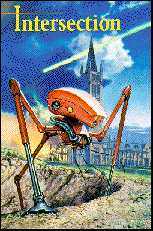home
>
SF
>
cons
> Intersection: Worldcon '95
Intersection: Worldcon '95

53rd World Science Fiction Convention
24 - 28 August 1995, Scottish Exhibition Centre, Glasgow
GoHs:
Samuel R. Delany
, Gerry
Anderson, (fan) Vin¢ Clarke, (filk) Bob Kanefsky
My second Worldcon. The large rooms at the SEC were fine, except for the
one 'partitioned' into four smaller 'rooms', said partitioning wonderfully
focusing the sound from each roomlet into the other three, allowing all
four programme items to be experienced simultaneously.
Sadly, Jon Brunner died while attending the Con.
Programme highlights
(Nothing from the first day, since I was flat out with food poisoning --
not caused by Con food, I hasten to add):
Panel: Negative Matter Supported Wormholes
John Cramer
, Geoffrey Landis,
Greg Benford
and
Bob Forward
on their recent joint
physics paper.
-
Wormholes can be stabilised by negative mass:
-
The Casimir effect is an attractive force between two metal
plates in a vacuum, because the plates halve the number of virtual
photon modes. This looks like negative energy, hence negative mass.
-
Or use negative mass cosmic strings
-
A wormhole can have a sphere at each end: 'two spheres of the same
diameter, each of which encloses the other'
-
Push a positive charge through a wormhole: the electromagnetic field
lines are not cut, so the wormhole appears to keep the +ve charge at its
entry mouth, and have a -ve charge at its exit. This build-up of +ve
charge repels more charge.
-
Push a positive mass through a wormhole: the gravitational field
lines are not cut, so the wormhole appears to keep the +ve mass at its
entry mouth, and have a -ve mass at its exit. This build-up of +ve mass
attract more mass.
Jack Cohen: Redesigning the Human Body for Fun and Fornication
If it weren't like this, how would it be?
A typical
Jack Cohen
talk, heavily illustrated
with slides of cartoons and photographs:
-
Universals and parochials.
If something has evolved on earth
more than once (flight, eyes, etc) it is a universal, and so aliens may
also evolve it. If something has evolved only once (the pentadactyl
limb) it is parochial, and so aliens are unlikely to have evolved it.
The universal four 'Fs': fur, photosynthesis, flight, mating.
-
We don't understand fertilisation.
Just because we can do
something, doesn't mean we understand it. We have many new ways of
making babies (surrogacy, AID, etc.), but we don't understand
fertilisation. Human reproduction and hormone cycles are very complex.
If we want to change these, we need to understand how it all works.
(Human male and female hormones are not 'opposites', they do not 'cancel
out', they are different.)
-
Rituals.
Reproduction and sexuality are too highly charged
for rational judgements. Humans cloak them in rituals, like puberty
rites and wedding ceremonies. Animals also have mating rituals:
behaviour during sex is very different from most survival behaviour, so
those instincts need to be overcome.
-
Range of sexual behaviour in animals.
Amazing photographs of
porcupines, damsel flies, butterflies, rhinoceros ...
-
Varieties of sex in humans.
We are all different from each
other, by about 10% of our genes. We are not like Model-T Fords with
just some different gadgets, we are more like hand-crafted cars, each
individually adjusted to give the 'same' result. Our small external
difference hide much bigger internal differences. Compared to these
differences, the difference between female and male are slight: the
developmental trajectories are very close. Nearly all attempts to alter
the trajectory result in something nasty.
-
Changing our minds.
If we want to change, more than altering
our bodies, we need first to alter our minds.
The Transactional Interpretation of QM, as recently
published
in Rev.Mod.Phys.
Consider a photon emitted by a galaxy a billion years ago, now caught on
a photographic plate on Earth. The Copenhagen Interpretation has a wave
front spread over a billion-light-year sphere instantly collapsing to a
point. Everett's Many-Worlds Interpretation has many parallel universes,
some where the photon hits different plates at different times, some where
it is never absorbed. The Transactional Interpretation considers both the
retarded and advanced waves, constructively interfering with each other
along the path between the emitter and absorber.
(Heisenberg's wave equation has two solutions, psi, and psi-star. Psi,
the retarded wave, which travels forwards in time, is standard solution.
Psi-star, the advanced wave, which travels backwards in time, is usually
discarded as non-physical.)
CI requires swallowing instant collapse of wavefunctions, hence faster
than light travel; Many Worlds requires swallowing prodigious replication;
TI requires swallowing time travel.
CI, Many-Worlds, and TI are all
interpretations
of the
same
mathematics. So they have no different predictions or observable
consequences. (The Transactional Interpretation
might
require an
open universe to explain the arrow of time, to cater for 'non-observed'
events of particles that are never absorbed.) Weinberg's attempt to add a
small non-linear component (for which there is no evidence) would
distinguish them: Everett can use it to communicate between parallel
worlds; TI can use it to communicate backwards in time.
Ptolomey had the Earth at the centre of the Universe, and everything
rotating around it. The Copenhagen Interpretation has the observer at the
centre of the Universe, and everything collapsing around it: "The
Collapsor of Wavefunctions".
Greg
Bear

